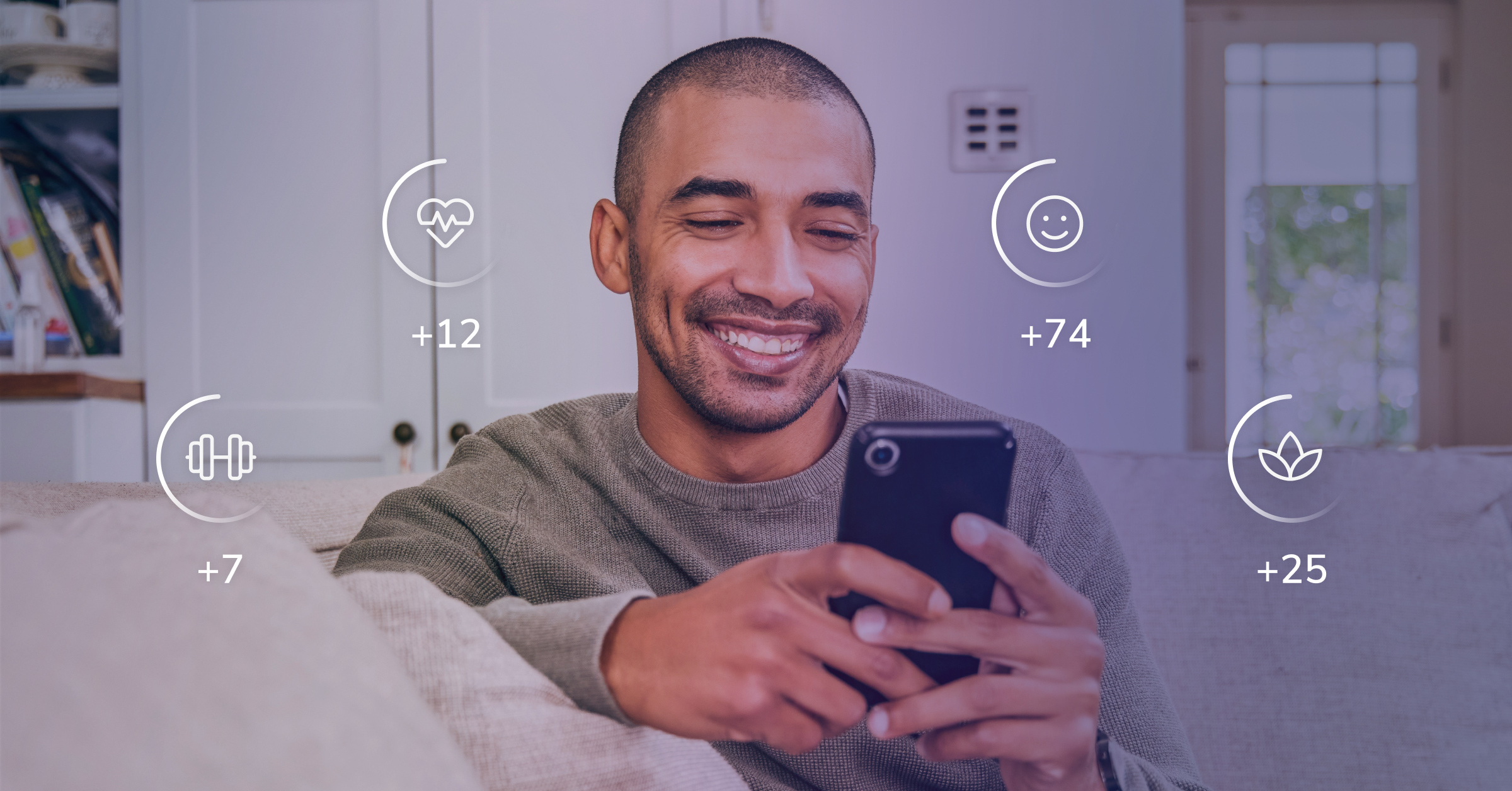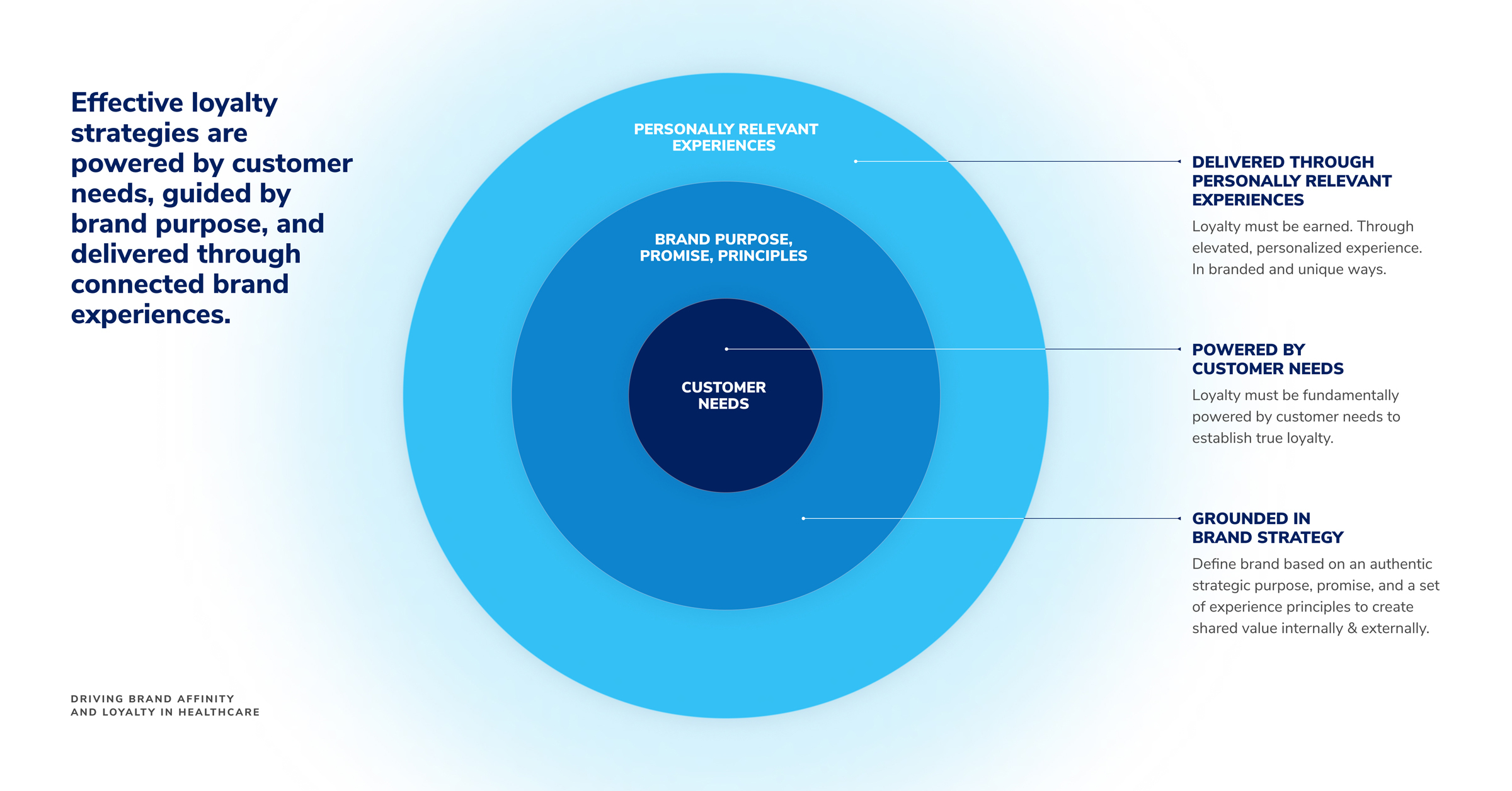Driving Brand Affinity and Loyalty in Healthcare

Loyalty is the outcome of great customer experience (CX). People are more loyal to brands that meet their needs and deliver value in personally relevant ways. Organizations and brands that can deliver on customer needs, grounded in their brand principles and delivered through personally relevant experiences, will make a lifelong impact with customers.
In healthcare, there’s another layer – organizations also need to have positive outcomes for customers related to their health and feel brands are safe, secure, and trustworthy.
According to McKinsey, “When asked to define personalization, consumers associate it with the positive experience of being made to feel special. They respond positively when brands demonstrate their investment in the relationship, not just the transaction.” These personalized experiences and the notion of “feeling special” often drive brand loyalty and are what make loyalty programs so successful today.

By exploring the entire end-to-end customer experience, you can understand the pain points, what customers truly want and need, and take action at the moments that matter the most. Whether it’s a loyalty program or an experience, it’s important to make people feel heard along the way. We can do this through:
- Capturing feedback at key touch points, understanding “the why,” and actioning upon it
- Recognizing and celebrating key milestones
- Delivering streamlined, elevated experiences
- Empowering associates to take action in real-time
- Giving members input on new benefits
- Delighting customers when they least expect it
- Keeping data safe and secure to build trust
What Does Loyalty Mean in Healthcare?
At Bounteous we support our clients in re-imagining what it means to show up and serve those who are most important to their business – patients, members, providers, employees – all in service of driving better health outcomes. With this focus, we build brand loyalty in new and innovative ways that matter.
To drive brand and organizational loyalty and drive health outcomes, organizations must focus on empowering and enabling people as they move through their very personal health journeys, facilitating:
- Adoption of employer-sponsored health and wellness benefit programs
- Connections to providers and educational resources they trust
- Easy access to health system care & services
- Adherence to care plans and medications
- Routine participation in preventive care services and screenings
- Recognizing customers for healthy choices in their everyday lives
Adoption of Employer-Sponsored Health & Wellness Programs (Employee Benefits Programs)
Many organizations rely heavily on benefits to keep their workforce healthy, productive, and loyal. But these benefits are only beneficial when employees use them. A lack of understanding and awareness of available benefits results in lower engagement and usage. According to Maestro Health, 35% of employees either don’t fully understand or know nothing about their healthcare coverage and benefits.
To maximize the value of their investment in benefit programs, organizations must successfully drive adoption and usage amongst their employees. By leveraging data, insights, and technology, organizations can implement personalized and event-driven awareness programs that connect individual members to relevant programs to engage immediately or remember later, when it’s top of mind and relevant. Delivering value that’s meaningful to consumers builds loyalty. By better understanding their benefits, employees are able to take better care of themselves and their families which creates a stronger connection to the organization.
Connections to Providers and Educational Resources They Trust
To build lasting relationships with their diverse audiences, organizations are also investing in creating authentic, culturally aligned content and experiences. They recognize the real opportunities to better reach and serve all audiences through culturally competent care. For example, social isolation for Adults 65+ and diverse under-served audiences has amplified the need to develop stronger relationships with one-to-one messaging through targeted channels, delivering content that is authentic and culturally relevant.
One example of how organizations have woven cultural relevance into their patient experience is with provider finders. In our continued work with health systems, there has been a focus on creating a provider finder that has the ability to be both personal and personalized. This includes the ability to indicate affinities or preferences (i.e. ethnicity, gender, language, LGBTQ) to connect users with providers with whom they may feel more comfortable.
Not only does creating stronger provider connections with people drive loyalty, but it will also improve health outcomes for high-needs populations: facilitating care adherence, management of chronic conditions, and preventative care and education.
Easy Access to Health System Care & Services
Keeping patients within the same health system makes it easier for providers to offer continuous, consistent, and coordinated care to their patients, leading to better health outcomes. But when it comes to finding care and services, patients have a lot of options, so health systems are investing in efforts to make it easy for patients to stay within their system including:
- Empowering care teams with technology that facilitates building stronger patient relationships to help address patient communication and consultation, appointment management, comprehensive views of patient data, specialist referrals, and telehealth options.
- Providing digital-first tools that give patients an easy way to manage all aspects of their care in one centralized place – including finding new providers, online scheduling, communication with care teams, test result assessments and appointment summaries, viewing and paying bills, managing medication, and telehealth scheduling.
- Leveraging claims data, patient journey data, and analytics to identify points of friction that can inform future investments in facilities, service lines, therapies, and care teams.
Adherence to Care Plans and Medications
In order to increase adherence to treatment plans and reduce readmission rates, healthcare systems are looking for opportunities to extend a patient care team’s reach beyond the point of care. They are exploring ways to leverage technology to provide support and motivate their patients outside of traditional care settings, including:
- Analyzing patient data and industry nonadherence insights to help identify at-risk patients and devise dynamic adherence plans that are tailored just for them.
- Orchestrating care team outreach and communications through a patient’s preferred channels to provide proactive and personalized coaching and support throughout their care regimen.
- Creating digital tools and apps that provide patients with real-time access to their care team, therapy and medication support, personalized care plans, reminders and alerts, and curated content.
By staying connected and involved in a patient’s care beyond the point of care, not only do health systems increase the likelihood of successful patient outcomes, but they strengthen the care team’s relationship with their patients.
Routine Participation in Preventive Care Services and Screenings
Many innovative health systems have already started to invest in ways to extend care into the homes of their patients, seamlessly integrating health into their daily lives. Whether it's empowering patients with customizable tools and apps they can use at home, or providing virtual evaluations and support, the desired outcome is the same: making it easier for people to stay engaged in managing their health outside of clinical settings.
A big focus is on how to leverage data, technology and artificial intelligence (AI) to bring trusted, expert care and content into the home - with privacy in mind. As an Example, CVS’ investment in Signify Health has allowed them to expand the reach of their value-based programs and increase patient participation and sustained engagement. By meeting patients where they are, Signify providers are building and maintaining trusted relationships, allowing them to identify issues before they escalate, leading to better outcomes for their patients.
Recognizing Customers for Healthy Choices in their Everyday Lives
Health insurance companies face a growing challenge in promoting preventive care and wellness among their members. To address this, they are turning to health-based rewards, which incentivize and reward members who take proactive steps to maintain their health.
Giving customers tools to track healthy living and recognizing them as they reach milestones, motivating them to keep going, are great ways to engage patients, improve their health, and foster loyalty. This has become easier through integrations with tracking apps that make being recognized more seamless.
Best Practices for Building Loyalty
As healthcare brands build loyalty with their vast array of customers they should keep these best practices in mind:
Empowerment: As people are empowered, infused with knowledge, connected with the right professionals and build trusted relationships, they build emotional loyalty that connects them with those that provide it for the long run. It’s important to give them the resources and tools they need to make the right decisions. In addition, empower your employees to take action and do the right thing for customers. Those are critical moments in the customer journey that make a lasting impact.
Personalization: Focus on personalized journeys and connected healthcare experiences to improve healthcare delivery – from reimagining the hospital visit experience for patients to unlocking keys for payers and providers to improve health outcomes for the future. It’s essential to meet patients where they are in their journey.
Trust & Safety: As brands begin to leverage data, technology and AI, trust and safety is paramount to maintaining strong relationships with customers. Ensuring customer data is secure and being transparent about how it’s used will go a long way. Delivering AI-driven experiences can be powerful and effective, but only if data is protected, context is part of the equation, and it makes the customer journey easier.
Cultural Awareness: Being culturally aware, having content tailored to customers, and allowing customers to make decisions about their healthcare providers based on their preferences is key. Without this foundation, healthcare companies can’t forge relationships with customers.
Measurement: Keeping a pulse on customer sentiment, capturing feedback on an ongoing basis, and evolving based on that feedback will set brands up for long-term success. Alignment on key metrics and measurement processes from the beginning will allow you to track and benchmark over time.
Strategy Powered by Critical Insights: Uncovering and leveraging critical insights should be a key part of a brand’s strategy. These critical insights will allow you to deliver optimized personalized experiences based on Digital Flow (a virtuous cycle of rapid realization of critical insights that inform and evolve a brand’s experience).
Keep It Human: Experiences should be both Personal and Personalized. Understanding moments that matter most to customers and delivering upon them in a way that’s specific to them establishes a virtuous cycle of loyalty.
Loyalty in healthcare is built on delivering personalized, value-driven experiences that prioritize health outcomes and foster trust. By empowering patients, providing culturally relevant content, ensuring easy access to care, and recognizing healthy choices, organizations can enhance loyalty and drive better health outcomes. It's crucial to prioritize empowerment, personalization, trust, cultural awareness, measurement, critical insights, and human-centered experiences to create lasting connections with customers.


